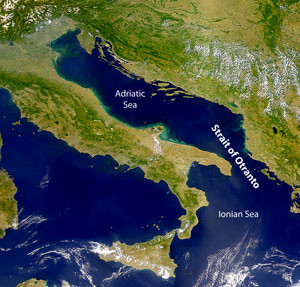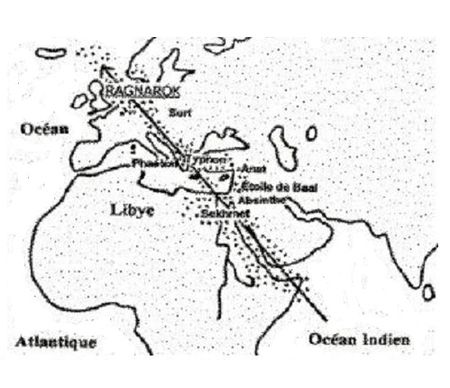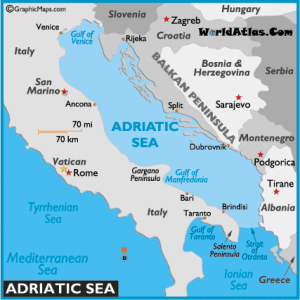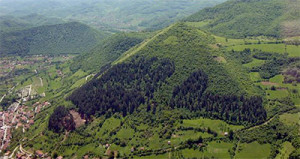Fatih Hodzic
Strait of Otranto, The
The Strait of Otranto is a 45-mile stretch of water that separates the ‘heel’ of  Italy from Albania at the entrance to the Adriatic Sea. It is also one of a number of proposed locations for the ‘Pillars of Heracles’ referred to by Plato. However, proponents of this idea are not agreed on the location of Atlantis, Fatih Hodži? places Atlantis in the Southern Adriatic Basin, while more recently, Alessio Toscano has opted for the northeastern Adriatic. An anonymous contributor to the all empires website(a) has an extensively illustrated entry, which designates the Albanian city of Durres as Atlantis and notes the multiplicity of locations that have referred to as the ‘Pillars of Heracles’, including the Strait of Otranto.
Italy from Albania at the entrance to the Adriatic Sea. It is also one of a number of proposed locations for the ‘Pillars of Heracles’ referred to by Plato. However, proponents of this idea are not agreed on the location of Atlantis, Fatih Hodži? places Atlantis in the Southern Adriatic Basin, while more recently, Alessio Toscano has opted for the northeastern Adriatic. An anonymous contributor to the all empires website(a) has an extensively illustrated entry, which designates the Albanian city of Durres as Atlantis and notes the multiplicity of locations that have referred to as the ‘Pillars of Heracles’, including the Strait of Otranto.
Phaëton
Phaëton in Greek mythology was the son of Helios the Greek sun god. Phaëton was also the name given to a comet that impacted or had a close encounter with the Earth in the 13th century BC. The Egyptians knew this comet as Sekhmet. Ancient inscriptions record that some of the consequences of this dramatic encounter were the drying up of the Nile and the desertification of Libya.
Michel-Alain Combes has noted(j) that Phaëton has also been associated “with Anat in Syria, the star of Baal in Canaan (Palestine and Phenicia), Absinthe, The star of the Apocalypse) among the Hebrews, Surt in the countries of the north.” He also suggests that the legends of Typhon (Hesiod) and Phaeton (Ovid), although usually thought to refer to separate events, are just different versions of the same encounter with a comet in the late 13th century BC.
Günter Bischoff has published two lengthy articles(n)(o) on the Atlantisforschung website which includes a comment that might account for the number of locations where apparent sightings of the comet were reported. “Now it is easy to explain why Phaethon should have been sighted over Greece, Egypt, Syria, India and other countries. During its orbits lasting several days, it will have flown over many inhabited areas on its elliptical orbit. Some observers may even have seen it several times and from different directions.”
A 2012 paper by Peter James and M.A, van der Sluijs entitled ”Silver’: A Hurrian Phaethon’ (l) concluded that “there is an attractive pattern of correspondences between the well-known Greek myth of Phaethon and the Hurrian myth of Silver.” Silver was a character in Hurrian mythology, also known as Ushu.
Interestingly, Plato records in Timaeus how Phaëton caused immense devastation but does not link it directly with the destruction of Atlantis but the context implies an event that was in the distant past, considerably earlier than Solon. Some ancient authorities, such as Eusebius and Isidore of Seville, have associated Phaëton with the time of Moses.
The poet Goethe considered the story of Phaëton to have had a real astronomical origin.
>Franz Xavier Kugler was a Jesuit priest who spent over thirty years studying ancient astronomical texts written in cuneiform. In 1927, he published a paper in which he concluded that a 1500 BC asteroidal impact in the Mediterranean inspired the story of Phaëton(r), an idea that could support the theories of Fatih Hodžic.<
>Immanuel Velikovsky has quoted from several of Kugler’s books in Worlds in Collision(t). In 1975 Malcolm Lowery published a more critical view of Kugler’s theories(u), concluding with the comment “thus we see in Kugler the triumph of preconceived ideas over objective investigation of all available evidence – the more surprising as Kugler could accept one interpretation of Plato to back up one aspect of his theory, but was unable to see its obvious similarity to Celsus and Manilius. In the last reckoning, it seems, he was unable to escape the yoke of uniformitarianism.”<
More recently, Bob Kobres has written several articles on the subject of Phaëton having a cometary origin(k). Some of these papers can be found on the Internet(a). Kobres dates this Phaëton event to around 1200 BC.
Stavros Papamarinopoulos from the University of Patras in Greece presented a paper to the 2005 Atlantis Conference held on Melos in which he linked Plato’s Phaëton with an encounter between the earth and cometary fragments around 1200 BC.
Emilio Spedicato opted for 1447 BC as the likely date of the Phaëton explosion. He describes this as a super-Tunguska event, which exploded over southern Denmark(m). He further contends that the after-effects assisted the Israelite Exodus from Egypt.
Spedicato’s identification is comparable with Jürgen Spanuth’s idea that Phaëton was a fragment of Halley’s Comet. Two other followers of Spanuth, Günter Bischoff and Walter Stender have written extensive papers, in German, on a meteorite impact with Northern Europe around 1220 BC, which they identify as Phaëton(c). The same interpretation has been applied specifically to Lake Chiemgau in S.E. Bavaria and is expanded on in papers by Barbara Rappenglück among many others(d)(f).
The late Bernhard Beier published an article on the Atlantisforschung website regarding Spanuth’s Phaeton theory that proposes a North Sea impact around 4.5km south of Helgoland with the consequent destruction of Atlantis. Beier concludes his comments with “Spanuth’s assumption that the Phaethon legend represents a mythical representation of catastrophic events from pre-Hellenic times corresponds exactly to Plato’s view of things and can therefore still be regarded as open to discussion. His chronological assignment of these events to the end of the ‘Bronze Age’ still seems worthy of discussion. On the other hand, the equation of the assumed Phaethon  impact with the Atlantis catastrophe, which he made quite naturally and without further ado, lacks any exegetical basis, even if it may initially appear quite logical in the context of Spanuth ‘s theory.”(p) There are aspects of the Phaëton story that are still debated. Was the Phaëton of Greek mythology inspired by a close encounter with a comet? Did it destroy Atlantis? Are we dealing with an impact or just a very close encounter? What was the flight path of the comet? One suggested route is shown here, where it was given different names along the way.
impact with the Atlantis catastrophe, which he made quite naturally and without further ado, lacks any exegetical basis, even if it may initially appear quite logical in the context of Spanuth ‘s theory.”(p) There are aspects of the Phaëton story that are still debated. Was the Phaëton of Greek mythology inspired by a close encounter with a comet? Did it destroy Atlantis? Are we dealing with an impact or just a very close encounter? What was the flight path of the comet? One suggested route is shown here, where it was given different names along the way.
Holger Kalweit, who also follows Spanuth in identifying Heligoland as a remnant of Atlantis, claims it was destroyed in 1222 BC by Phaëton.
Clube & Napier [0290] have proposed a slightly later date of 1369 BC for the encounter with Phaëton.
Dale Drinnon has argued(g) against any connection between Phaeton and the destruction of Atlantis saying “There are two different kinds of catastrophes being described and distinguished from one another and the Phaethon event is categorically differentiated from the Destruction of Atlantis in the Atlantis dialogues of Plato. There is no good reason to equate the two and certainly no textual justification for doing so.”
Allan & Delair refer to the central cause of the catastrophe described in their book[014] as Phaëton, which they claim was cosmic ejecta from a supernova in the Vela constellation. Maurice A. Williams in his review(q) of their book noted how the authors deduced that ancient Mesopotamian observers named this cosmic intruder Marduk as it caused great disruption in the Solar System, including the destruction of the planet ‘Tiamat’ creating the Asteroid Belt and capturing Tiamat’s satellite ‘Kingu’, which in turn disintegrated near Earth causing the biblical Deluge. This deadly journey was also seen by the Greeks and called Phaëton by them.
Amanda Laoupi offers an extensive article on the history of the Phaëton myth and its interpretation in both ancient and modern times.
Phaëton was also the name given by Johann Gottlieb Radlof (1775-1829) to a planet that he believed disintegrated after a collision with a comet, within human memory, resulting in the asteroid belt.
Today, we have an asteroid called 3200 Phaeton which is the source of the annual Geminid meteor shower(s).
(a) Comet Phaethon’s Ride (defendgaia.org)
(b) https://www.migration-diffusion.info/article.php?year=2011&id=259
(c) http://www.efodon.de/html/archiv/vorgeschichte/bischoff/2003-SY5%20bischoff_phaeton.pdf
(d) http://impact-structures.com/news/Stoettham_c.pdf
(f) https://guginew.blogspot.ie/2011/09/fall-of-phaethon-greco-roman-geomyth.html
(g) Archive 3605
(j) http://www.astrosurf.com/macombes/Article_Sekhmet,_Phaeton,_Surt_et_les_autres.htm (French)
(k) Archive 3365.
(l) https://www.researchgate.net/publication/274336666_’Silver’_A_Hurrian_Phaethon
(m) https://interval.louisiana.edu/conferences/2007_Stenger/Slides_of_talks/mose8-6.pdf
(t) Franz Xaver Kugler | The Velikovsky Encyclopedia *
(u) “F. X. KUGLER — ALMOST A CATASTROPHIST”) (defendgaia.org) *
Red, White and Black
The Red, White and Black stone which Plato said had adorned the buildings of its port city, has led Atlantis seekers to eagerly follow up this apparently obvious clue. However, as with so many aspects of the Atlantis story, this particular detail does not provide us with anything like a clear pointer to any specific location.
Jürgen Spanuth relates[015.125] how the ancient Canarians decorated their temple with red, white and black rock, the colours of tufa, pumice and lava. The cliffs of Santorini are also known to display red, white and black rock. These three materials are frequently found in the vicinity of volcanoes(b) and may be considered a valuable clue to the location of Atlantis. However, this combination of rock colours is not exclusive to volcanic localities as Jim Allen has demonstrated at Pampa Augallas in the Andes and Peter Daughtrey at his Silves site in Portugal[0893.120].
Although Atlantis was destroyed by an earthquake, volcanoes are often located in the same general region such as in the Central Mediterranean which is both seismically and volcanically very active and, in my opinion, the prime candidate as the home of Atlantis. This view is endorsed by Plato himself who twice (Tim.25b & Crit.114c) told us that the territory of the Atlantean alliance stretched from North Africa as far as Tyrrhenia in Italy. I further propose that this was on a north/south axis.
Jim Allen has found the same three rock colours at his Bolivian site and further afield, Ian Wilson points out[185] that red, white and black bricks were used extensively in Çatal Hüyük. Not to be excluded, Diaz-Montexano has produced photos on his website of pre-Roman structures near Gibraltar that incorporate red, white and black blocks in their construction. Jonas Bergman has indicated that similarly coloured stone is to be found in Morocco. Other locations include the Azores, Algeria and Sardinia.
Andrew Jones, a professor of archaeology, has noted that the builders of Carn Ban, one of the ‘Clyde Cairns’ on Scotland’s Isle of Arran employed red white and black stones in its design – pure coincidence I’m sure! Robert Hensey in his book on Newgrange [1766.39] refers to Jones and the growing interest in the use of colour in ancient monuments.
>Fatih Hodzic in an attempt to enhance his claim of an Adriatic Atlantis has noted; “The Atlanteans used stone for building: ‘one kind was white, another black, and a third red’. White and black stone is still quarried on Island Bra? (Croatia) and red stone in the Bay of Kotor (Montenegro).”(c)<
Some(a) have sought to link the red, white and black of the Nazi swastika with Plato’s reference!
(b) How are volcanoes and earthquakes related? | Volcano World | Oregon State University (archive.org)
Adriatic Sea
The Adriatic Sea was mainly dry land during the last Ice Age until it was inundated between 8500-6000 BC. The last decade has seen a number of sites in  the Adriatic region nominated as possible locations for Atlantis. A sunken town near Zadar would appear to be the latest candidate(d).
the Adriatic region nominated as possible locations for Atlantis. A sunken town near Zadar would appear to be the latest candidate(d).
Fatih Hodzic, a Slovenian writer, has offered of a new theory(a), which places Atlantis in the southern Adriatic Basin. He contends that the destruction of Atlantis was a consequence of an asteroid impact, recorded in Greek mythology as Phaëton, impacting in either the Ionian or the Tyrrhenian Sea just west of Sicily.
Recently, Alessio Toscano has suggested that the Pillars of Heracles were situated at the Strait of Otranto and that Plato’s ‘Atlantic’ was in fact the Adriatic Sea(c).
The Italian side of the Adriatic has also had claims made of an association with Atlantis such as with Valbruna. Daniela Bortoluzzi has written a lengthy article suggesting a possible link between Atlantis and Venice(h). More detailed is the claim by Morven Robertson that Atlantis had been situated between Padua and Ferrara, not far from Venice.
Mljet is a Croatian island close to Dubrovnik and believed by some to be Homer’s Ogygia, which in turn has been identified as Atlantis. This same island offers a competing claim to be the place where St. Paul was shipwrecked on his way to Rome, rather than Malta. At the risk of offending my Maltese friends, I consider the Mljet claim to have some considerable merit. Apart from anything else, at that time ships, for reasons of safety, preferred to stay close to shore, which suggests that to use the Strait of Otranto would provide the shortest open sea journey available, after that the Strait of Messina would bring them straight up the Italian coast to Rome! I find it hard to understand how at any point on that route that a storm could have threatened to carry them to Syrtis Minor (Southern Tunisia) which was about 400 miles at the nearest point.
Dubrovnik was recently claimed to have a number of pyramids in its vicinity by Pero Metkovic as well as the location of Atlantis. His rather rambling blog(g) offers no evidence apart from over-imaginative speculation.
Another claim is that satellite imagery has revealed a network of lines near Durrés, west of Tirana in Albania, which are the remnants of Plato’s Atlantean canals. The co-ordinates are 41.08-41.02 N and 19.23 E. A blogsite(b) is also home to a number of articles adding support for this Durrés theory.
Andi Zineli, in a now defunct website, advocated an Albanian solution to the mystery of Atlantis. He employed the Oera Linda Book to support his theory.
While the above suggestions are interesting, they are not convincing. Does it not seem strange that had Atlantis been located in the Adriatic, next door to Greece, that the Greeks in general and Plato in particular would have been unaware of it?
The Adriatic was also the backdrop to Homer’s Odyssey according to a new book[1396] by Zlatko Mandzuka, himself a native of the region. Even more radical is the claim that Troy itself had been located in Bosnia-Herzegovina or adjacent Croatia, the former by Roberto Salinas Price in 1985[1544], while more recently the latter is promoted by Vedran Sinožic[1543].
When the sunken ruins of a city, dated to around 1500 BC were discovered in 2015, near Croatia’s oldest city, Zadar, it generated the usual flurry of Atlantis speculation.
There was a media report(f) in early 2017 in which Mark Kempf claimed to have discovered the remains of Atlantis 30 miles off the coast of Croatia. Kempf is a treasure hunter and hopes that the discovery by him and his team will yield a fortune. I consider this report to be somewhat dubious.
>Nevertheless, although it cannot be directly linked to Atlantis, I feel obliged to add a May 2023 report that a “prehistoric road was discovered under layers of sea mud at the sunken Neolithic site of Soline, and helped connect the Hvar settlement to the now-isolated island of Kor?ula in Croatia(i). The ‘road’ has been dated to around 5000 BC.<
(a) http://en.atlantida.spletnestrani.com/atlantida/
(b) http://atlantisinalbania.blogspot.com/2008/07/name-and-location.html
(c) http://templeofapollobelenus.blogspot.ie/
(d) https://www.reddit.com/r/worldnews/comments/3u7rce/archeologists_in_croatia_announced_their/
(f) https://empirenews.net/lost-city-of-atlantis-uncovered-in-mediterranean-sea/
(h) https://www.acam.it/tracce-di-atlantide-a-venezia/
(i) 7,000-Year-Old Ancient Road Found Buried Underneath the Mediterranean Sea! | Weather.com *
Bosnia
Bosnia was dragged into the Atlantis debate in 2006 when a self-styled archaeologist, Semir Osmanagic, claimed that he had discovered five pyramids in his ancestral Bosnia near the town of Visoko. His claim received widespread media coverage and sparked a debate that continues today.
Osmanagic maintains that the largest one is bigger than the Great Pyramid at Giza and that the Bosnian pyramids date to 12,000 B.C. In response, Archaeology Magazine noted that “Construction of massive pyramids in Bosnia at that period is not believable. Curtis Runnels, a specialist in the prehistory of Greece and the Balkans at Boston University, notes that “Between 27,000 and 12,000 years ago, the Balkans were locked in the last Glacial maximum, a period of very cold and dry climate with glaciers in some of the mountain ranges. The only occupants were Upper Paleolithic hunters and gatherers who left behind open-air camp sites and traces of occupation in caves.”(j)
The Atlantis connection emerged from the belief of Osmanagic that the original ancestors of the Maya, Basques and other ancient peoples were descended from the peoples of Atlantis and Lemuria whose founders arrived on earth from the Pleiades. According to Osmanagic’s strange logic this gives the ‘pyramids’ of Bosnia an Atlantean pedigree.
Fortunately, Mark Rose, editor of Archaeology, who published a critical review(a) of Osmanagic’s weird ideas in Archaeology magazine, was also widely quoted, adding some balance to the debate. The same magazine carried a brief but highly critical review of Osmanagic’s theories from Zahi Hawass(h).
In 2006, Robert Schoch visited the Bosnian ‘pyramid’ and subsequently wrote a highly critical assessment of Osmanagic and his theories. However, sometime later, Osmanagic responded with a scathing review(c) of Schoch’s work!>I have included here the opening paragraph of Schoch’s comments which may explain Osmanagic’s reaction. “I have seen the corrupting effects of money in Bosnia. I am referring to the so-called Bosnian pyramids located in the Visoko region. Initially, I was excited by the expectation of very old pyramids (claims circulated that they were 10,000 years or older). Upon visiting the site, I discovered a massive money, power, influence, and nepotism driven swindle.”(n).
In 2013, Dominique Görlitz published a report of his investigation of the Bosnian pyramids in which he concluded “that at least the Great Pyramid of the Sun and the lesser Pyramid of the Moon are not the archaeological remains of an unknown civilization” (o).<
In September 2014 the Science Channel aired an episode of The Unexplained Files series in the US, which attempted to justify Osmanagic’s claims. However, Jason Colavito has highlighted the many flaws in the program’s content(d).
A more sober attempt to link the Bosnian region with Atlantis has been made by Fatih Hodzic(b). Part of his theory attempts to identify the thousands of stone blocks or ‘stecaks’, spread widely in Bosnia, as remnants of Atlantean buildings. His ideas are interesting but unconvincing.
Not content with having Atlantis in Bosnia, Roberto Salinas Price, in 1985 [1544], also proposed Bosnia as the location of Homer’s Troy.
In 2014, Paul A. LaViolette visited the Visko pyramid in Bosnia and published an extensive illustrated article in which he expressed his amazement at what he saw there and concluded(g) that he considers “this to be one of the most important archaeological excavations going on at this time on our planet.”
Philip Coppens has also defended the reality of Osmanagic’s pyramids in The Lost Civilization Enigma[1275.39], nevertheless, the debate is still open as can be seen in a February 2016 blog(f), in which many reasonable questions relating to the construction of the ‘pyramids are still unresolved. For my part, I find Osmanagic’s personal credibility questionable, considering his previous claims regarding Atlantis and ancient aliens, which are not, in my view, the conclusions of a person with his critical faculties intact.
Another claim from Osmanagic emerged in April 2016, when he claimed that huge stone spheres that exist in Bosnia ‘prove’ the existence of an advanced civilisation more than 1,500 years ago(e)!
Atlantisforschung published an article by Osmanagi? in which he highlighted the Bosnian spheres while also referencing other spheres discovered in the Adriatic region as well as in various countries around the world(l). Conventional geology describes most spheres outside of Costa Rica as natural concretions(m).
Nevertheless, a pretty vigorous defence of the reality of the Bosnia pyramids was published by Richard Hoyle on the Ancient Origins website in January 2020(k).
Late 2018 saw the UK’s Express tabloid’s online edition entertain us with the headline(I) – Bosnian pyramid SHOCK: ancient civilisation received knowledge from SPACE.
(a) https://archive.archaeology.org/online/features/osmanagic/
(b) http://en.atlantida.spletnestrani.com/atlantida
(c) Wayback Machine (archive.org)
(f) See: Archive 3187
(g) https://www.sarajevotimes.com/?p=72522
(h) https://archive.archaeology.org/online/features/osmanagic/zahi_hawass.pdf
(j) https://archive.archaeology.org/online/features/osmanagic/
(k) https://www.ancient-origins.net/ancient-places-europe/bosnian-pyramid-0013212
(l) News about the Bosnian stone balls – Atlantisforschung.de (atlantisforschung-de.translate.goog)
